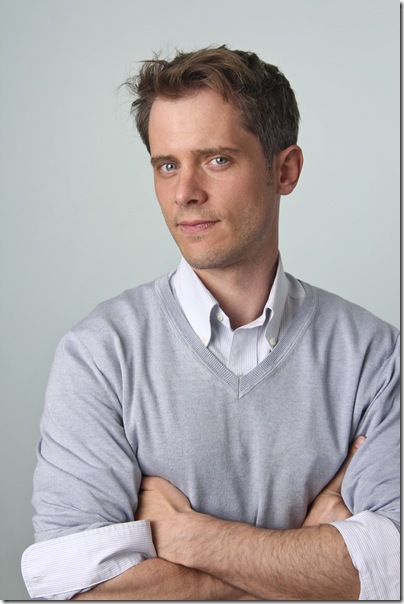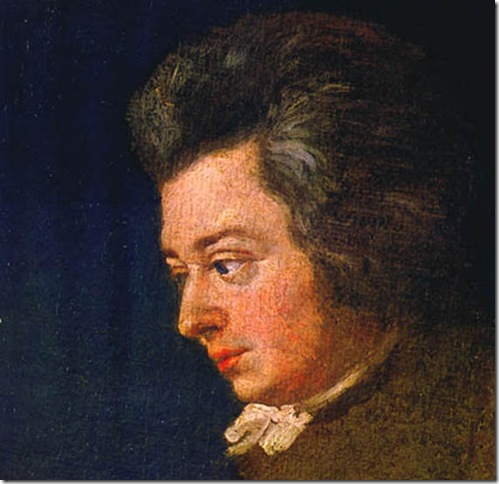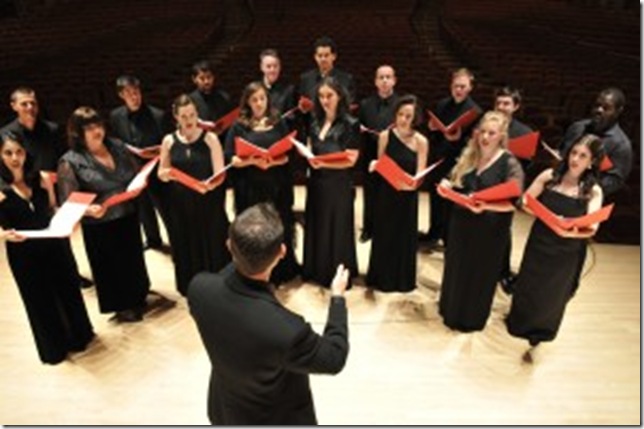The first thing Gregory Spears wants you to know is that he’s not trying to complete the Mozart Requiem.
Even though he has.
The American composer sees his three new movements for the iconic work, which have their world premiere Friday, less as a solution to a Mozart puzzle then as a continuation of a dialogue with Mozart and with the continuum of Western sacred music.
But still: Being asked by Miami’s Seraphic Fire concert choir to supply the three Requiem movements Wolfgang Amadeus Mozart did not get to write before his untimely death in December 1791 “absolutely” made Spears more than a little apprehensive.
“Before I could start, I had to figure out a way to deal with that, just the anxiety of approaching this important work … I had to conceive of it in my mind not as a completion of Mozart but as a completion of the piece,” Spears said. “And I think what opened the door for me is when I started studying the piece closer, Mozart had many different kinds of music in his portion of the piece. It’s very highly inspired by Baroque, by Bach and especially Handel.
“And so he was very much looking to his predecessors, and not trying to best them, or in any way compare himself to them, but simply to use that music and carry on, which is what I think is so fascinating about liturgical music. I hear a certain selflessness when (composers) engage with it. There’s always such an engagement with tradition,” he said. “That tradition of liturgical music always being multi-voiced, always being multi-authored, really allows me to enter into this tradition, not as a completer, but as a collaborator.”
This week, Seraphic Fire will present the Mozart Requiem (in D minor, K. 626) in three performances accompanied by the Firebird Chamber Orchestra, with three new versions of the Santcus, Benedictus and Agnus Dei composed by Spears, a 36-year-old Virginian now living in Brooklyn who holds degrees from the Eastman School of Music and Yale University, and a doctorate from Princeton.
Spears’ music includes a Requiem, composed in 2010 for six singers and a chamber ensemble including viola, troubadour harp and electronic organ, and highly evocative of early music. He has written a good deal of vocal music, works for piano, small chamber groups, and orchestra, and after the Mozart performances, he heads to Ohio for a 10-day workshop residency at Cincinnati Opera for his fourth opera, Fellow Travelers, based on Thomas Mallon’s 2007 novel about young love in the shadow of McCarthyism.
Few stories in music history are as fraught with foreboding as that of Mozart and his Requiem, since it was this Mass for the Dead the 35-year-old composer was working on when he was stricken with his fatal illness. The story goes like this:
In July of 1791, Mozart was approached by an intermediary (probably not masked, as folklore would have it) who commissioned the work for an anonymous patron. That patron was Count Franz von Walsegg, a young nobleman whose even younger wife, Anna, had died at 21 in February of that year, and for whom he wished to have a requiem performed.
Walsegg has gone down in Mozart legend as a man who commissioned pieces from famous composers in the community and then passed them off as his own, but more research reveals that he simply copied the parts himself and then would invite his guests to guess who had written it. In any case, Mozart was a very busy man at the time; in addition to writing The Magic Flute, he had just been commissioned to write an opera seria, La Clemenza di Tito, to celebrate the accession of Emperor Leopold II as king of Hungary and Bohemia.
He wrote Tito quickly (about six weeks) and then finished The Magic Flute in time for its premiere at the end of September, at which point he began work on the Requiem. He scored the Introit and Kryie in their entirety, and laid out eight further numbers in vocal score and figured bass at the time of his illness in late November. It was a fairly gruesome ailment — probably rheumatic fever, followed by kidney failure — one that caused Mozart’s body to swell so much that his wife’s mother and sister had to make him a night shirt that he could put on from the front so he wouldn’t have to turn over.
Nevertheless, he was expected to recover, and it was only about two days before his death on Dec. 5 that he and his family understood that he was not going to survive. One of the last things he did, according to the testimony many years later of his sister-in-law Sophie Haibel, was discuss with his sometime amanuensis, composer Franz Xaver Süssmayr (1766-1803), how he thought the Requiem should be completed (Süssmayr had composed the recitatives for Tito, Mozart being pressed for time).
And it was on his mind at his very last moment, according to Haibel, whose reminiscences, written in 1825, are still heartbreaking to read:
“The last thing he did was to try and mouth the sound of the timpani in his Requiem,” she wrote to Georg Nissen, Constanze’s second husband and an early Mozart biographer. “I can still hear it now.”
Although his widow, Constanze, initially asked composer Joseph Eybler to finish the Requiem — Mozart had received only half the 100-ducat fee and was going to get the rest when the work was done — it was Süssmayr who got the assignment after Eybler did some work on it and then gave up, and it is Süssmayr’s completion that has been performed ever since.
Other completions have been done by later scholars and composers, but apparently Mozart left no music behind for what he had in mind, though Constanze later said that she saw Süssmayr remove some pieces of paper from Mozart’s desk, and the supposition has been that those scraps contained some original Mozart material for the missing movements.
“The past since Mozart’s death has been almost as important to the piece as Mozart himself,” Spears said. “Just the way that people have understood and interpreted, and read and misread the piece, has become a whole tradition in itself.
“I actually kept tiny fragments of Süssmayr, which in certain sections are played over and over. If you know Süssmayr, you’ll definitely hear Süssmayr in the three movements that he wrote. There’s a lot of little nods to Süssmayr, but for me the idea is that as a purely speculative thing, I wanted to listen to the Süssmayr and say ‘What might one of those little scraps of paper that he found had written on it?’” he said.
“There are these couple phrases in Süssmayr that are so gorgeous I just could not live without them. My fantasy, of course, is that is what had been left on the desk,” he said. “What I don’t like about the historical tradition is the Süssmayr -bashing that has happened. When you hear mine, you’ll definitely hear where I agree with him and where I disagree with him. But the way in which he’s been treated hasn’t been history at its finest.”
Süssmayr, indeed, had a thankless task. In addition to orchestration, he had to come up with three movements. His Sanctus has a short opening, then a fugue; the Benedictus opens with a gentle quartet that scholars strongly suspect is based on some original material, then a reprise of the Sanctus fugue. The Agnus Dei is a short, mysterious-sounding movement with some surprising harmonic changes that leads to the Lux aeterna, which is a repeat of Mozart’s opening movement, including the Kyrie fugue.
Spears’ score for the three movements runs about 18 minutes, about twice the length of the Süssmayr version. A review of the score shows the music to be contemporary but at the same time conversant with music of Mozart’s time without being pastiche.
“For me, style always has meaning. I’ve been called a post-minimalist in certain pieces and a neo-Romanticist in others,” said Spears, who added that he welcomes such titles. “For example, my interest in minimalism comes into this piece with those Süssmayr fragments. When those come in, the piece will fall into a sort of looping pattern, and that’s definitely my style, something Süssmayr and Mozart would never have done … Of course, repetition plays a very big role in their styles, but the meaning behind my repetition — and it’s not important for an audience member to hear it this way — is that it sort of attempts to hold onto this tiny fragment of music that is slipping away from us.
“For me, it’s very tied to the idea of ‘requiem.’ We’re trying to hold on to something that we know is disappearing. And so the repetition becomes a sort of elegiac device,” he said. “So minimalism factors in, in that way, and yet the material sounds very Classical.”
Spears sees a connection here, too, with the pioneering American minimalist Steve Reich, an enthusiast for the Baroque and for early music dating back to figures such as the 13th-century French composer known to history as Pérotin.
“In this case, the repetition is of Classical music, and yet this idea of the layering and the imitation that you see in the voices is a nod to the Baroque … There’s a tradition before Mozart, there’s a tradition of Mozart, and then there’s a tradition of my world, all coming together. I think it sounds like all of those things,” he said.
Spears’ Sanctus (in B-flat minor) opens with propulsive music in three-quarter time that rocks back and forth between the dominant and the tonic over a pedal tonic, contrasted with a slow Hosanna (in C-sharp minor) in which the scale motion of a new melody introduced by the sopranos is falling, rather than rising as in the Sanctus.
The Benedictus (in D-flat major) begins with the vocal quartet singing a gently unfolding series of motifs in which a turn figure is prominent, all over a pulsing Schubert-like accompaniment in strings and basset horns. The chorus enters, then the vigorous music of the Sanctus returns fortissimo, and the chorus and orchestra explode in an outburst of rushing scales that suddenly stops as the opening music returns.
For his Agnus Dei (also in B-flat minor), Spears switches the pulse to two beats in a bar, with a melancholy theme in triplets over a harmonic framework whose occasional asperities add to a feeling of regret, perhaps evocative of the “peccata mundi” in the text. The music builds to a loud and powerful climax, which is answered first by a return to the opening music and then, at the end, a transition to B-flat major, with a consolatory new theme drawn from Süssmayr’s Benedictus, ending with the vocal quartet and a brief transition of orchestral chords and pauses to the closing Lux aeterna.
The Seraphic Fire performance also will evoke the way the Requiem likely was first presented, at a memorial service for Mozart early in 1793, and again late that year, when Walsegg was able to have the Requiem he’d paid for performed for his wife’s memorial. The text of the Requiem Mass in the church service has other parts that Mozart didn’t include, such as a Gradual and a Tract.
For these performances, Spears asked Seraphic Fire founder and director Patrick Dupré Quigley to add in the traditional music for parts of the Requiem service composers usually don’t set.
“I’ve asked Patrick if we could really make a nod to the liturgical purpose of the piece and add in these plainchant movements which Mozart didn’t set,” Spears said, and Quigley agreed.
Seraphic Fire’s managing director, Joey Quigley, said the group is delighted with Spears’ work.
“Seraphic Fire’s collaboration with Gregory Spears to complete Mozart’s Requiem epitomizes Seraphic Fire as a whole,” Quigley said in a prepared statement. “This weekend’s performances will be a landmark not just for our organization, but for all of South Florida’s arts community.”
Spears is part of the new generation of American classical composers that has sometimes been called “indie classical,” musicians who are happy to blend influences from across the musical spectrum and approach the writing of music in a utilitarian, forthright way that consigns the ivory tower to the landfill of history.
In addition to his commissions, Spears teaches theory and composition at the Third Street Music School Settlement in New York’s East Village, and also teaches part-time a freshman writing course at Princeton. The composer says he feels “very positive” about the current classical music environment.
“I feel very grateful that I’m living right now,” he said. “Arts institutions are struggling, and you don’t want to belittle or ignore that. But I think the general feeling is that it’s an exciting time to be a composer, and that while composers certainly aren’t household names, there’s a world and environment here (in New York) with offshoots into all sorts of other (geographic) areas. D.C. has a wonderful music scene. Houston has a wonderful music scene.
“There is a sense of positiveness and possibility. My friends are getting commissions, they’re getting work,” he said. “And I’m just addicted to it. I just want to able to write music and to keep writing it. That’s the goal at the end of the day.”
Seraphic Fire presents the Mozart Requiem, with three movements by Gregory Spears, at 7:30 p.m. Friday at All Saints Episcopal Church in Fort Lauderdale, at 8 p.m. Saturday at First United Methodist Church in Coral Gables, and at 3:30 p.m. Sunday at St. Gregory’s Episcopal Church in Boca Raton. The Friday and Saturday performances are sold out; tickets for Sunday ($55) can be had by calling 305-285-9060 or visit www.seraphicfire.org.


